Pebble Time vs Apple Watch: Which is the smartwatch to buy?
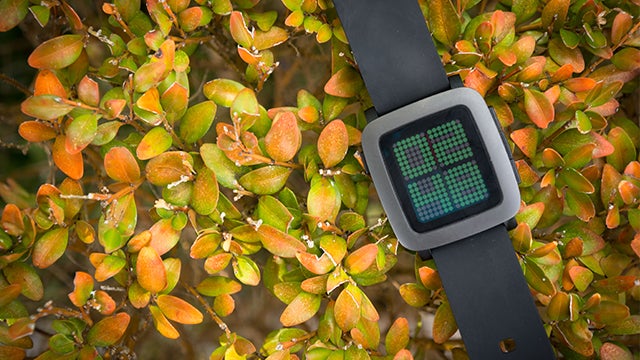
Apple Watch or Pebble Time? Here’s our verdict on what the two smartwatches are like to live with
It’s been more than three years now since Pebble turned to crowdfunding to launch its first smartwatch with monochrome display and week-long battery life. The record-breaking campaign, underdog nature of the tiny start-up and charisma of founder Eric Migicovsky combined to create something that caused quite a stir.
The resulting product was about as basic as you could get. The Pebble smartwatch buzzed when you received a message, displayed the first few lines of your latest email and burst into life when a call was coming through. Its successor, the Pebble Time, does all those things – but it’s more refined.
We’ve been using both the Pebble Time and its most high-profile competitor, the Apple Watch, for a while now and have plenty to say about our experiences. Although in terms of design and software both watches are very different, there are some similarities too. And, if you own an iPhone then they’re the best smartwatch options out there.
Here’s how the Pebble Time and Apple watch match up.
Build and straps
The original Pebble had more in common with a toy than a striking piece of tech when it came to design. The combination of all-plastic chassis and display with a dodgy strap made it feel like something that had been whipped up of a weekend in our garage.
With Apple opting for a high-end look and feel for its smartwatch, Pebble knew that the Time had to make big strides in this department. We’ve been wearing the Pebble Time for a while now and the improvements are obvious. But it still lacks that bit of polish we’ve come to expect from device costing £179.
Watch our Apple Watch vs iPhone race across London
SEE ALSO: iPhone 6 vs Samsung Galaxy S6
The most noticeable change is that it’s no longer all plastic. Instead, there’s a new metal bezel that sits atop a plastic body. It’s nice to see a classier addition here, but the plastic sitting below the metal cover still feels very bargain-basement. It’s almost as if the metal plate is there simply to cover up what’s beneath it.
We’re also not convinced by how well it will hold up against scuffs following extended use, although it doesn’t seem to have picked up any damage in our initial testing. We’ve found that our stainless-steel Apple Watch is very prone to scratches, but these can easily be eradicated with some regular steel polish.
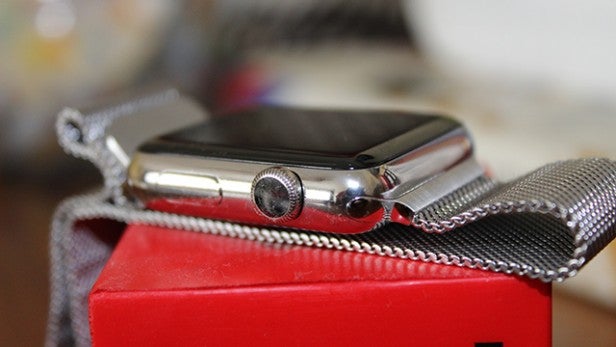
We were also hoping that Pebble would have extended its use of metal to the buttons. As with previous Pebble editions there’s no touchscreen, so navigating the device is completely by way of the side-mounted buttons.
These buttons are a pain to press, however. There isn’t enough traction when you push down on them and there’s no feedback either. Compare this to the Apple’s Digital Crown and the responsive display and the difference is as night and day.
Another strange thing we’ve noticed with the Pebble is just how harsh sounding its vibration motor is. While the Apple Watch gives you a gentle tap when you receive a notification, the Time shakes violently. It shakes so much that you can hear it from across the room: we left it in a bag and you could easily hear it vibrate in there. It’s not pleasant.
If you care about your smartwatch being waterproof, then the Pebble Time is for you. Its 3ATM rating means it’s suitable for wear in the shower and whilst swimming – and we experienced no issues in our tests. The Apple Watch, on the other hand, isn’t suitable for such activities. Some users have taken it out for a swim, but Apple says the Watch is water-resistant so you can sweat, run in the rain and wash the dishes with it around your wrist.
There’s one area where the Pebble Time wins out over the Apple Watch, and that’s how it sits on your wrist. Maybe we’re not used to wearing more sizeable watches, but we found that the Apple Watch felt very noticeable. It didn’t sit like a watch; it didn’t feel natural on our wrist. The Pebble Time does, however. It feels great, and we reckon this is all down to the curved bottom that fits comfortably over the contours of your wrist.
SEE ALSO: Apple Watch tips and tricks
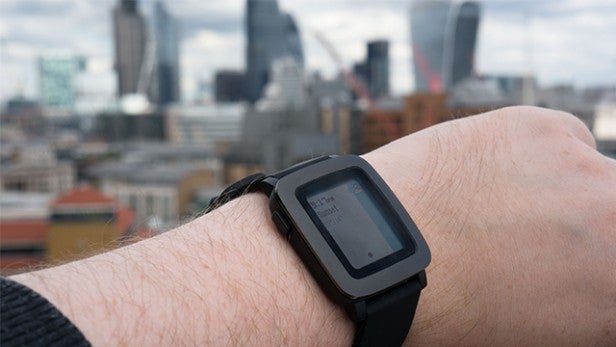
On the whole, though, Apple has definitely outdone Pebble when it comes to design – but that was never really in doubt. The Watch is available in a range of finishes, from stainless steel to aluminium to rose gold, and it feels far more luxurious than the Pebble. Like the majority of Apple products, it’s well built and completed to a high finish.
The straps are a big part of any watch, but it’s an area that many smartwatches have so far got very wrong. Whether it’s the Moto 360, the LG Watch Urbane or even the Fitbit Surge, all have been let down by the strap.
Apple has managed to buck the trend. It has produced straps in all shapes and sizes – leather, stainless steel, silicone – and all with an array of styles and buckle types to match. We’ve been using the Milanese Loop band for the majority of time with the Watch, whilst also on occasion trying out the Sport Band. The Milanese Loop is certainly one of the sleekest, but it costs an extra £129, which is only £50 shy of a complete Pebble Time.
It’s the Sport Band that’s most comparable with the Pebble Time. Both feel similar in the hand, although they’re made from different materials: the Time’s band is made of silicone while the Apple Watch’s is constructed from fluoroelastomer. Each has a soft, matte texture, and are available in a couple of colours. We did find that they both got a bit sweaty when they’d been on our wrists for some time and we even experienced a minor rash after the first few days of wearing the Pebble Time.
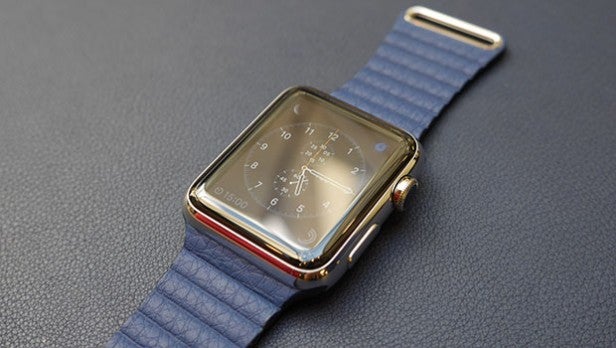
What Pebble really has on its side is universal support. Since the straps are of the standard 22m size, you can easily slide off the original and instantly have access to thousands more – even straps you already own. With Apple you’re limited to the straps the company sells and the ones it licenses. All available at significant cost.
The displays couldn’t be further apart
There’s plenty we don’t like about the Apple Watch, and while everyone in our office has differing opinions on many aspects of the device, there’s one thing we all agree on: the display. Apple’s Retina displays have long been some of the best on the market, and the 38mm (340×272) and 42mm (390×312) versions on the Watch are no different. They’re gorgeous: bright, sharp and with excellent viewing angles. It’s the best display we’ve seen on a smartwatch.
But there’s also something about the screen that we dislike: it’s not always on. Unless you’re directly looking at the display, the Watch looks like a blank chunk of metal sitting on your wrist. Not like a watch at all. By using a colour e-paper display that consumes much less power than the OLED panel on the Apple Watch, the Pebble Time is always on and displaying the clock.
Obviously, the Apple Watch panel is far sharper. The Pebble Time has more in common with a GameBoy Advance than Cupertino’s wearable, but we’re not really complaining. The thing is, we won’t be using our watch to look at videos, pictures or do a lot of reading – and for everything else the bright, colourful display on the Pebble Time is all we need.
The main issue we have with the Pebble Time’s display is the bezel. Actually, the bezel that surrounds the bezel. There so much of it surrounding the screen that it just doesn’t look very good.
Both devices performed quite well in sunlight, but the Pebble’s e-paper display was better. Viewing angles in sunlight deteriorate far more quickly on the Kickstarter-funded wearable, though – tilt it even slightly and all you’ll see is glare.
We’ve yet to suffer scratches on either screen. The Apple Watch uses sapphire crystal to protect the display – the Sport version uses toughened glass – while the Pebble Time uses strengthened 2.5D glass, which gives it a slight curve. We’ll update this is that changes in the future.
One lasts for a week, the other for only a day
One of the Pebble’s main selling points is how it bucks the trends of current smartwatches and extends battery life far beyond just one day. Yes, we’ve seen other watches – such as the Withings Activité – stretch this out to six months but they have a very limiting feature set. Pebble claims you should get seven days worth of juice from the Time, while Apple recommends you charge the Watch every night.
Big difference.
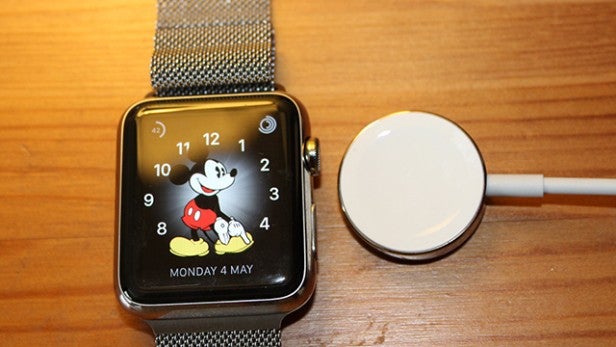
In reality, the Pebble Time falls short of those lofty claims, but it’s still much better than the competition. We fully charged the device on day one and it lasted for five solid days before we had to reach for the magnetic, proprietary charger. It charged quickly, though, going from 0 per cent to fully charged in a little under two hours.
Obviously, this far outclasses the Apple Watch – although you have to take into account that Apple’s Watch does a lot more. As far as smartwatches go in general, the Apple Watch is still one of the better when it comes to battery life. It’ll easily last a day, and if you forget to charge it overnight, you shouldn’t wake up with a dead weight on your arm – and have missed the train as your alarm didn’t go off.
Both have software issues, but there’s hope
Take note that, for this feature, we’ve mainly been using our Pebble Time with an iPhone. Why? Well because the Apple Watch is compatible only with iOS devices. If you want a wearable for use with your iPhone, you’ll most likely be opting for either the Pebble or the Apple Watch.
But, the Pebble Time is compatible with Android too – and it’s so much better on the Google platform. This isn’t Pebble’s fault, but more to do with Apple’s tight lock over the iOS ecosystem.
When you receive a notification, and you’re using iOS, the only option is to dismiss it. On Android, however, you can actually act on it. Shoot off a canned response or use the built-in microphone to dictate a message. That’s a big feature disparity right there. Basically, on iOS you can look at the message on your wrist, but then you have to pull out your phone to do anything. On Android you can look and send a reply, with the phone still in your pocket.
SEE ALSO: Android Wear tips and tricks
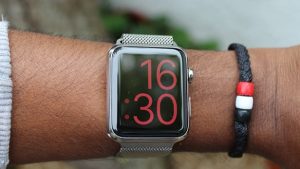
On the Apple Watch you can dictate and reply to messages through preset responses if you’re using the official iMessage app, but things aren’t quite so clear cut with others. You can’t reply to a WhatsApp message for instance, but you can “Like” a Facebook post.
Both will display all the general notifications that come to your phone, regardless on whether there’s a dedicated app on the wearable. News alerts, sports scores and so on will all buzz your wrist.
Another difference between using the Pebble Time on iOS and Android is that the latter gives you more granular control over notifications, so you can pick which come to your phone and which go to the watch. On iOS, it’s all or nothing – and depends on your phone settings.
Pebble has completely overhauled its operating system for the Time, heading in a new direction to previous iterations. The focus is the “Timeline”, an overview of your life. Using the hardware buttons you can scroll through your day, viewing calendar appointments and weather updates along the way. Apps can also plug into this, so ESPN can add in sports scores; an airline could add your flight details; and Trip Advisor can tell you somewhere good to go for lunch.
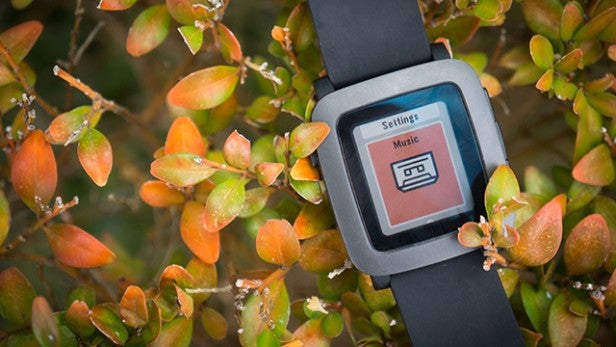
It’s an idea that Apple seems to have taken some cues from in its upcoming Apple watchOS 2 updates, which will be landing later in the year. But the colourful look and kiddy-style animations probably won’t go down as well with those looking for a serious experience.
We definitely prefer the way that Pebble has worked its UI to that of Apple, which has basically taken the entire idea of a phone and ported it over to the watch. But neither can hold a candle to Android Wear, and its fantastic way of using Google Now cards to display information when you need it.
Fitness features: Can they replace a Fitbit?
While Apple has clearly tried to position the Watch as a fitness accessory, the Pebble has pushed it as much. Instead of building its own apps, the start-up has let the companies such as Jawbone and Misfit handle this. The Time also lacks a heart-rate monitor, which is present in the Apple Watch.
As already mentioned, the one thing the Pebble Time does have over the Apple Watch is that it’s waterproof. You can dive down to 30m without risking damage to the smartwatch, while Apple advises you take the Watch off for anything more wet than heading out in the rain.
The Apple Watch definitely has more going for it if you’re a gym bug, though. You can import tunes and connect up a set of Bluetooth headphones, while there are also two dedicated apps for tracking all your vital stats. It wasn’t completely accurate 100% of the time though, so if you need a device that’s more spot-on then we’d still recommend a dedicated running watch from a recognised brand such as Polar.
The Pebble is fine with basic step-tracking: both the Misfit and Jawbone Up apps beam the data back to their companion smartphone apps and they work fairly well.
If you’re happy with a wearable that can track your steps, calories and so on, the Pebble Time will work for you. But it’s the Apple Watch that has a greater number of features and, while we haven’t found it to be 100% accurate, it definitely has more scope to become your gym buddy.
There’s a big difference in price
It might seem a strange thing to do, but it’s important to compare these two devices in terms of value for money. Not so much by comparing their bases prices, because the cheapest Apple Watch is £120 more expensive than the Pebble, but by looking at what you get for your extra outlay.
Even though it’s cheaper than Apple Watch, we still feel the Pebble Time is actually a bit overpriced at £179. The first edition of the Pebble retails for between £89 and £99, and after applying the Timeline update, it will have pretty much all the same features as the Pebble Time. To put the price into even more perspective: you can bag the Sony SmartWatch 3 and Moto 360, both of which run the far superior Android Wear, for less than the Pebble Time. During our time with the device we really struggled to feel this was a device that represented value for money.
Just like any other Apple product, the Watch is an investment. The basic Sport model starts at £299, but you’ll probably want the slightly larger 42mm version, which costs £339. We’d also recommend switching out the Sport Band for those times when you’re not actually at the gym or out on a run, which could cost you upwards of £100 if you’re looking at official Apple versions.
SEE ALSO: Best Fitness Trackers 2015
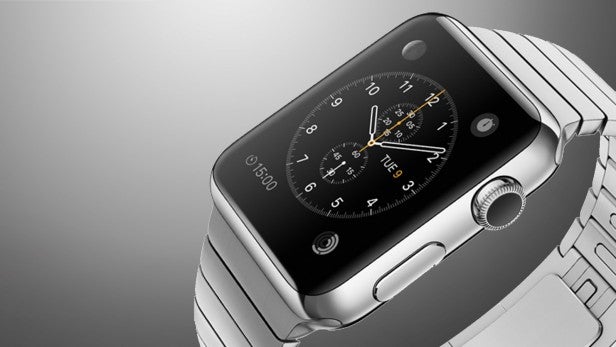
You do get a much more rounded device with the Apple Watch, or even an Android Wear competitor, but you’re going to be paying for it. And you’re getting something that will likely be updated in the future. Even watchOS 2 looks to right many of wrongs of the first version. There will also always be a much more thriving accessories market, plus much more interest from developers creating better apps and trying to look for that ‘killer feature’.
Thing is, if you solely want a notification machine you probably only need the Pebble Time.
Apps: Turns out they’re not that important on a watch. Yet.
This might come as a bit of a surprise, but in their current state apps are not an important part of the smartwatch. Well, we can rephrase that slightly. The apps themselves aren’t important, it’s how plug in to the rest of the system that is.
SEE ALSO: Here what’s new in WatchOS 2
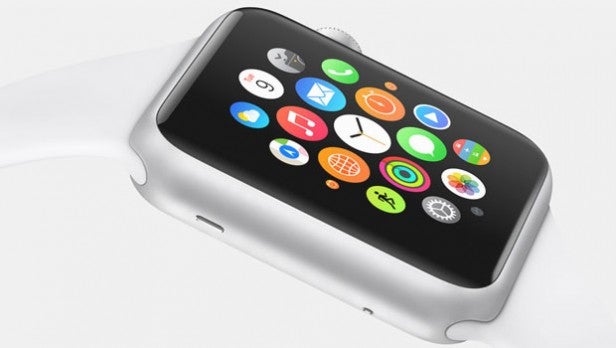
In the time we’ve been using the Apple Watch and Pebble Time, we have only opened up dedicated apps on a few occasions. On the Apple Watch we’ve tended to jump more towards Glances, those little tidbits of information accessible with a swipe up, as they’re much faster than going into an app.
We’re also much more likely to use apps that plug directly into Pebble’s Timeline, but this is limited right now. We’ve currently got TripAdvisor, ESPN (though that one is a bit US-centric for us football-loving folk) and a couple more to choose from, but hopefully that list will grow once more people have these on their wrists.
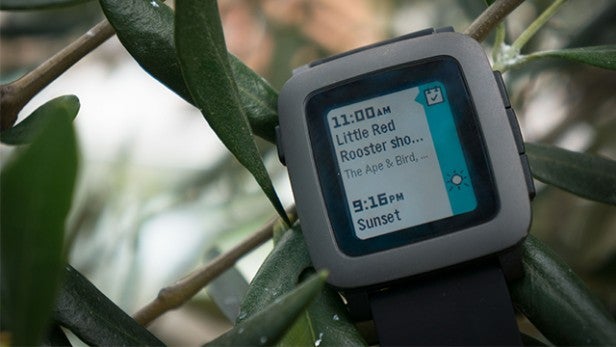
Apple has the most apps, that’s clear, but we really won’t see the best of these until native support comes later in the year. Until then, or until the apps generally get better and faster than pulling out your phone, apps just aren’t that important on your watch.
So, which one should you buy?
We had high hopes for both of these wearables, but overall we’re a little disappointed with the Apple Watch and the Pebble Time. They both miss the mark in several key areas.
While the Time improves upon the look of the original, it still feels cheap and lacks the classy touches that make a watch desirable.
The Apple Watch might be sleek, but you’d expect no less for the pricey outlay. And even though the Pebble Time is much cheaper, it still feels a little bit expensive for what you actually get.
For basic notifications, they both tick most boxes. However if you want full support you’re best off going with the Apple Watch as with it you can not only view messages, but act upon them. That’s a shame, but it’s more the fault of Apple’s tight hold over the iOS ecosystem rather than Pebble.
Apps on both are somewhat disappointing too, though for differing reasons. Apple’s App Store is plentiful, but performance issues tend to bog down the majority of downloads. Pebble, on the other hand, lacks the support from developers that it needs to build swathes of enticing apps. Hopefully, this situation will improve.
We still think that smartwatches are for the enthusiasts only and while both the Apple Watch and Pebble Time have plenty of positives, we’re not sure whether they’re ready for the mass-market yet.
So, which would you pick? Apple Watch or Pebble Time? Let us know in the comments section below


